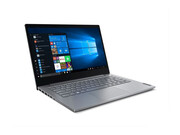Lenovo ThinkBook 14-IML-20RV005WGE
Specifications

Price comparison
Average of 1 scores (from 4 reviews)
Reviews for the Lenovo ThinkBook 14-IML-20RV005WGE
Source: Laptop Media
 Archive.org version
Archive.org versionAnother disadvantage is the relatively poor touchpad experience and the unevenness in the keyboard feedback. Thankfully, though, the laptop has a fingerprint reader, embedded in the Power On/Off switch. Interestingly enough, the ThinkBook 14 has a 25W L1 Power Limit, which provides quite the headroom for a high frequency, during long time periods. However, the cooling is not really able to cope with it, which results in very high temperatures during full load.
Comparison, online available, Very Long, Date: 03/04/2020
Source: Think Digit
 Archive.org version
Archive.org versionThe Lenovo ThinkBook 14 is essentially an IdeaPad model with a couple of essential enterprise features thrown in, such as support for user data encryption and a wide choice of full-size IO ports. CPU and storage performance is in line with what's expected but the same can't be said of its display and touchpad. If you're willing to live with these glaring issues, you consider the Lenovo ThinBook 14 as your machine of choice at your small or medium business.
Single Review, online available, Very Long, Date: 12/03/2019
Rating: Total score: 73% price: 62% performance: 80% workmanship: 69%
Foreign Reviews
Source: XT Mobile
 VN→EN Archive.org version
VN→EN Archive.org versionPositive: Powerful processor; premium design; solid workmanship; rich set of ports; big screen. Negative: Thick frames; average GPU performance.
Single Review, online available, Very Long, Date: 03/03/2020
Source: Nghenhin Vietnam
 VN→EN Archive.org version
VN→EN Archive.org versionPositive: Attractive price; premium design; solid workmanship; metal case; nice ergonomy.
Comparison, online available, Medium, Date: 11/27/2019
Comment
Intel UHD Graphics 620: Integrated GPU (GT2, 24 EUs) found on some Kaby-Lake-Refresh CPU models (15 W ULV series). Technically identical to the previous Kaby-Lake GPU called HD Graphics 620.
Modern games should be playable with these graphics cards at low settings and resolutions. Casual gamers may be happy with these cards.
» Further information can be found in our Comparison of Mobile Graphics Cards and the corresponding Benchmark List.
i7-10510U: Comet Lake based low power quad-core processor (technically identical to Whiskey Lake and still produced on 14nm++). The CPU cores can clock between 1.8 and 4.9 GHz (all 4 cores 4.3 GHz max.) with HyperThreading (8 threads). The integrated memory controller supports DDR4-2666 and using cTDP up/down the performance can be adjusted by the OEM (10 - 25 Watt possible, 15W default).» Further information can be found in our Comparison of Mobile Processsors.




